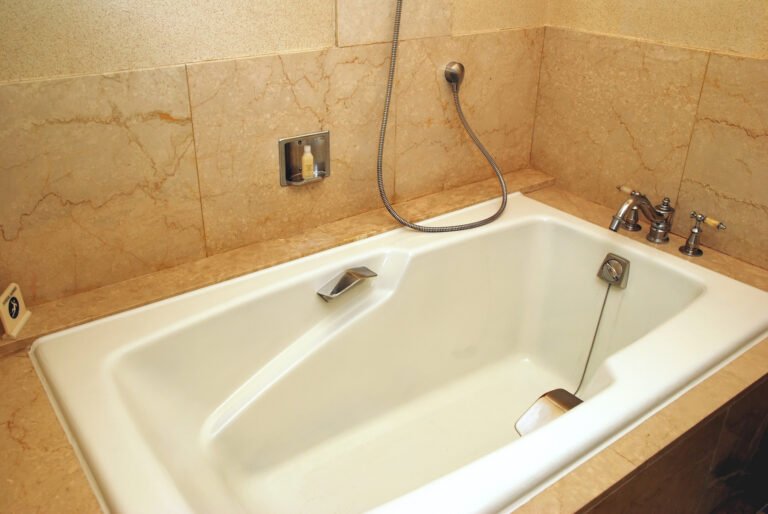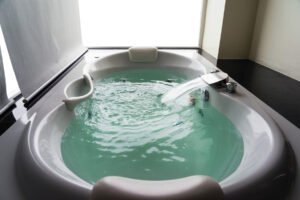Bathtubs are one of the most high-impact but overlooked accessories of any bathroom that often go through their share of daily wear and tear. Once damaged, bathtubs look old and uncool, crippling the whole bathroom decor.
But since bathtubs are a bit pricey, you can’t just go and replace them every now and then! So, how do you refinish them to look as good as new without burning a hole in your pocket? Yes, you’re thinking right! By painting the tubs. But can you really paint bathtubs? If yes, what paint and tools do you need! Let’s find out!
You can paint a bathtub with any heavy-duty paint, but the preparation and workability will vary according to the material. While cast-iron, metal, plastic, and acrylic bathtubs are much easier to paint, stone or marble bathtubs must be filled, sanded, and cleaned before painting.
Which Bathtubs Can You Paint Efficiently?
Bathtubs come in various materials like fiberglass, metal, plastic, and even porcelain. But, while materials like fiberglass, stone, and acrylic are easy to paint, some materials like copper and crystal do not adhere well to paint. So, let us list down the bathtub materials that you can paint.
1. Can You Paint a Fiberglass Tub?
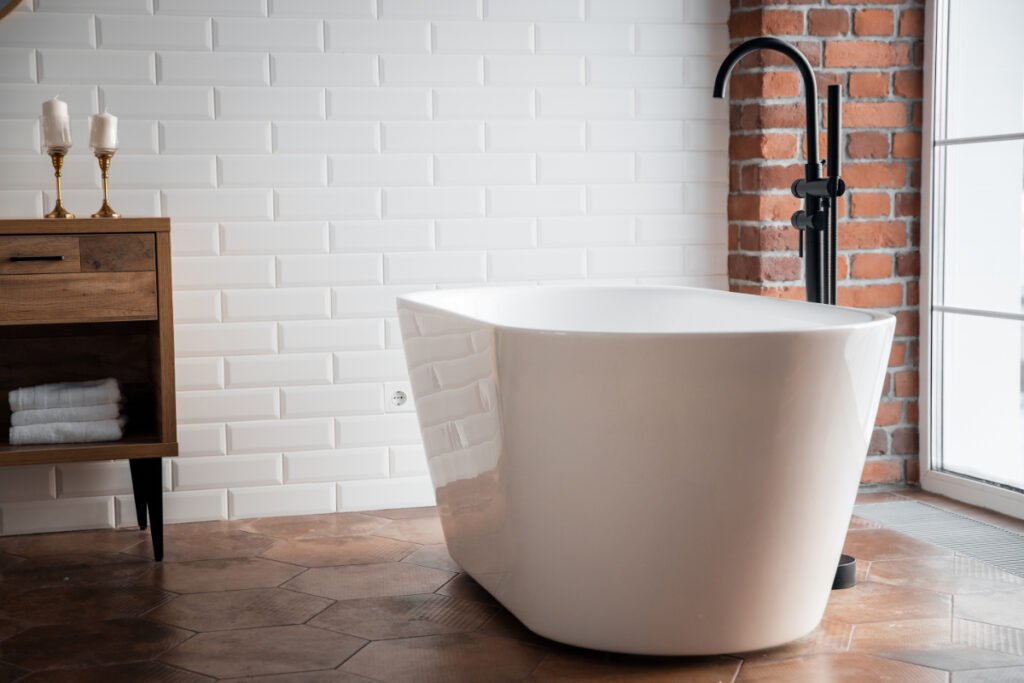
Yes, you can paint a fiberglass bathtub, but first, you must remove all the caulk with a putty knife or a screwdriver. Moreover, since fiberglass has a plastic-like finish, you must use good-quality, commercial-grade epoxy paint to avoid peeling.
But, if your fiberglass tub has a smooth, gel coat finish, you need to wash it thoroughly with an abrasive cleaner, remove all the soap scum, and sand it a little with fine-grit sandpaper or steel wool. You can use the acrylic or aerosol spray cans for quick painting and drying.
Alternatively, If your fiberglass tub has an acrylic finish, prime it with a latex primer beforehand. Then, seal it with a second coat of clear, polyurethane coating for extra durability.
If possible, paint your bathtub in a garden or deck to eliminate all the toxic fumes emitted by epoxy paint. Additionally, wear a mask or a respirator for added protection.
2. Can You Paint a Plastic Bathtub?
Plastic tubs can be easily painted with any latex, enamel, or acrylic paint using a bonding agent. But first, you must prepare the surface using a specialty spray primer, remove all grease, grout, and minerals using a heavy-duty cleaner, and then sand it lightly with steel wool, flint, or varnish.
After that, you can finish it with a brush roller and bind the top coat with a heavy-duty sealer that prevents warping and peeling.
Let your plastic bathtub dry and cure for 2-3 days or at least 48 hours before pouring hot water into it.
3. Can You Paint an Acrylic Bathtub?
Yes, acrylic baths can be painted, but you’ll need to warm them up to melt the shiny, plastic-like finish and create a coarse surface for the paint. Later, you can resurface the tub with a second coat of acrylic luster or soft enamel glazing from DIY bathtub refinishing kits.
Moreover, acrylic bathtubs don’t require much prep work before painting. Just wipe off the soap scum and grout with acetone, fix and fill any cracks or chips with sealing glue, and sand it lightly. Then, you can paint it with any acrylic, latex, or spray paint.
Install a silicone caulk where the bathtub meets the shower tile to create a tight water seal and prevent the paint from chipping off.
4. Can You Paint a Stone Bathtub?

You can paint a stone bathtub easily, but make sure to fix any cracks, chips, or holes first. Moreover, if you have a stone resin bathtub, you must scuff the surface roughly to remove the glossy polish and clean it with regular dish soap and water to remove any dirt before painting.
If you have a coarse, natural stone bath, you can skip the sanding process and start painting directly with heavy-duty epoxy paint. Alternatively, you can use a clear coat of polyurethane finish to revamp your bathtub’s shine while preserving its natural texture.
Since natural stone is a porous material, it’ll absorb the first few coats of bath paint, and you’ll need about 3-4 coats for a smooth finish.
5. Can You Paint a Cast Iron Tub?
Painting cast iron bathtubs is tedious, but you can use any durable acrylic urethane enamel paint that adheres well to the surface and prevents corrosion. Prepare the surface by removing rust and flaky material, sanding with an emery paper, and priming with an oil-based primer.
After that, you can start painting. Once you finish, seal the top surface with an enamel spray for a shiny, polished look.
Sand the surface again with high-grit sandpaper after priming to help the paint adhere well.
6. Can You Paint Over a Marble Bathtub?
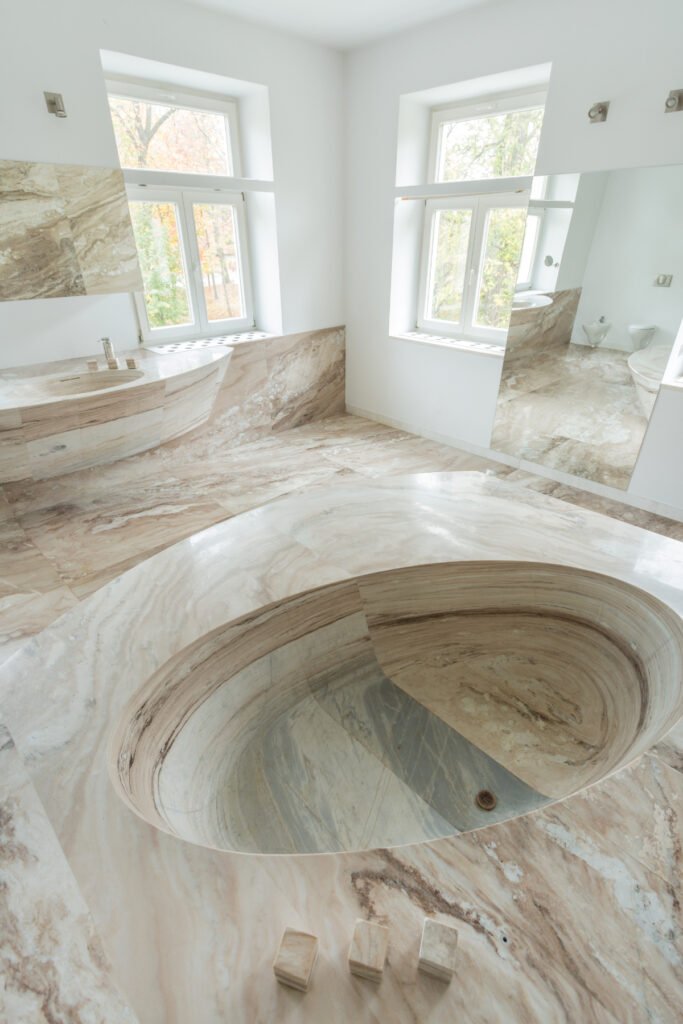
Marble bathtubs are very smooth and might easily peel or tear off the paint layer. But you can still paint them by creating a rough foundation using a stone spray and then rubbing it with flint. Then, after sanding and priming, you can paint it using epoxy or latex paint or the Rustoleum tub kit for an even finish.
To help the paint last longer, it’s always good to seal the top surface with a gel-resin coat.
7. Can You Paint a Porcelain Bathtub?
Yes, porcelain tubs are easily paintable. Plus, their coarse enamel finish makes painting even more effortless. You can use shinier latex, epoxy, or enamel paint to design a modern, industrial look for your porcelain bathtub.
However, since it has a shiny, porous surface, you’ll need to do prep work before painting it. Start by cleaning the surface with lime, shaving cream, or any mild cleanser, and spray it with alcohol to remove the debris efficiently.
After that, prime it using any metal primer, paint it, and top it off with a moisture-resistant sealer for more durability.
Wipe your tub with a rough muslin cloth and a surface repair epoxy solvent to hide the hairline cracks, chips, and scratches.
Which Type of Bathtub Does Not Adhere to Paint?
- Chipped or Cracked Tubs: If your bathtub has some major cracks and holes, it won’t hold water well, and it’s better to replace it. You can fill any minor cracks and chips with a filler, but those won’t hold onto bigger holes effectively.
- Copper Bathtubs: Copper naturally forms a thin patina or film on its surface that protects the metal from corrosion but does not adhere well to paint.
- Crystal Bathtubs: Crystals are textured, uneven, porous, and have a lot of holes on their surface. Plus, their transparent surfaces do not go well with paint and might look awful from the outside.
What Kind of Paint Should You Use for Painting Bathtubs?
Generally, water-proof acrylic, epoxy, latex, and polyurethane paints are the best for bathtubs as they form a durable, water-resistant finish that doesn’t peel off easily. Avoid chalk, emulsion, or distemper paints as they may peel off with moisture and soap scum.
- Acrylic Urethane Paints: These paints are popular for metal, cast-iron, and porcelain tubs and are the least expensive paints available in the market. However, they give a plastic-like, high-gloss finish that’s easy to clean but might not suit a traditional bathroom.
- Latex Paint: Latex paints are a classic for stone, marble, or acrylic tubs and are extremely easy to clean, cure, and maintain. They come in both water-based and oil-based coats, but they require proper prepping and filling up all the cracks and crevices before painting.
- Acrylic Paint: Acrylic paint adds a semi-gloss finish to textured and porous materials like stone, porcelain, and ceramic and is very easy to clean and maintain. However, to last longer, it needs a top coat of a good-quality sealer or bonding agent.
- Epoxy Paint: Epoxy is a commercial-grade paint that offers the highest durability and works with almost any bathtub surface. The paint prevents rust and corrosion in metal bathtubs and protects against mold and mildew in ceramic ones. However, epoxy takes a lot of time to dry and may emit fumes during the painting process.
Which is the Best Paint Finish for Your Bathtub?
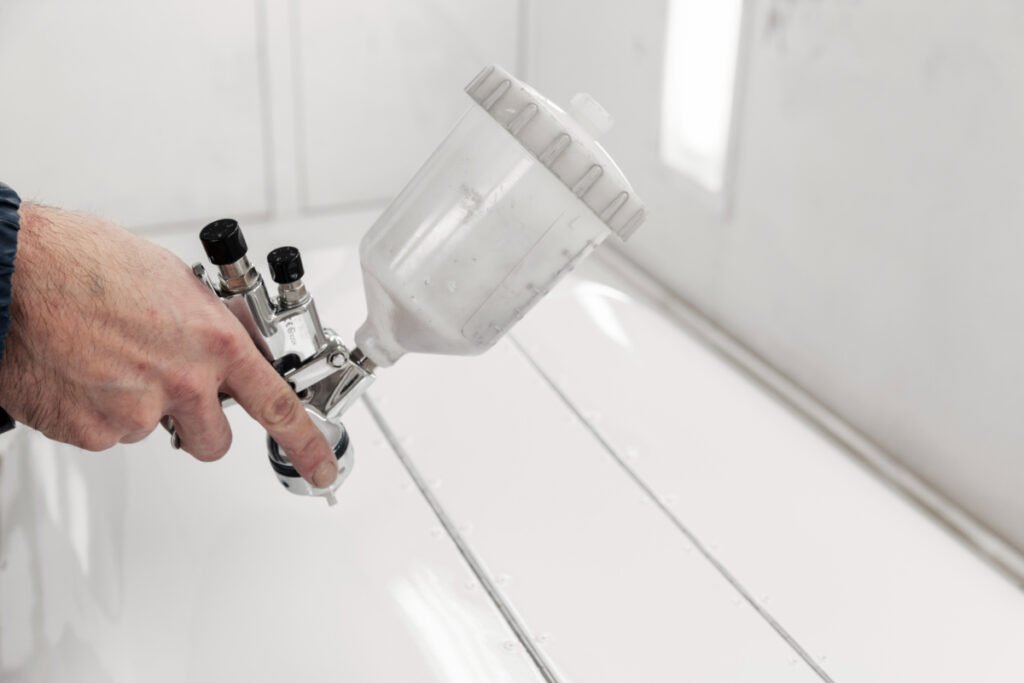
Paint finishes generally depend on the material and the type of design you want to have with your bathtub. While metal and fiberglass tubs look industrial and modern with semi-gloss and high-gloss finishes, other materials like stone, ceramic, or porcelain look textured, furnished, and vintage with simple satin finishes.
- Matte, Flat, and Eggshell Finishes: Matte finishes tone down the shiny look of your bathrooms and add a luxurious feel to your bathtub. However, they do not resist molds and mildew effectively and might peel off quickly. Hence, using a high-quality binding primer with these finishes is advisable.
- Satin Finishes: Satin finishes are easier to clean and add a crisp, eclectic appeal to standard tubs. Moreover, they resist water effectively and do not peel off easily, making them the right tap for porous materials like stones and ceramics.
- Semi-gloss Finishes: Semi-gloss finishes are easy to dry, clean, apply, and protect the tub from water, corrosion, and weathering. They add a modern and industrial feel to tubs and do not stain easily.
- High-gloss Finishes: High-gloss finishes offer the highest resistance to water and moisture but highlight the cracks, holes, and other deformities on the surface. Hence, they require proper prep work and priming in advance.
Which is the Best Spray Paint for Bathtubs?
Standard Rust-Oleum tub sprays, plastic sprays, 2k enamel sprays, epoxy sprays, and polyurethane sprays are the best spray paints for bathtubs. These paints will withstand the high moisture and usage of a bathtub and create a durable film that will keep rust and weathering at bay.
On the other hand, emulsion, chalk, or lacquer spray paints might come off quickly in contact with water and, hence, unsuitable for bathtubs.
How to Paint a Bathtub With a Bathtub Refinishing Kit?
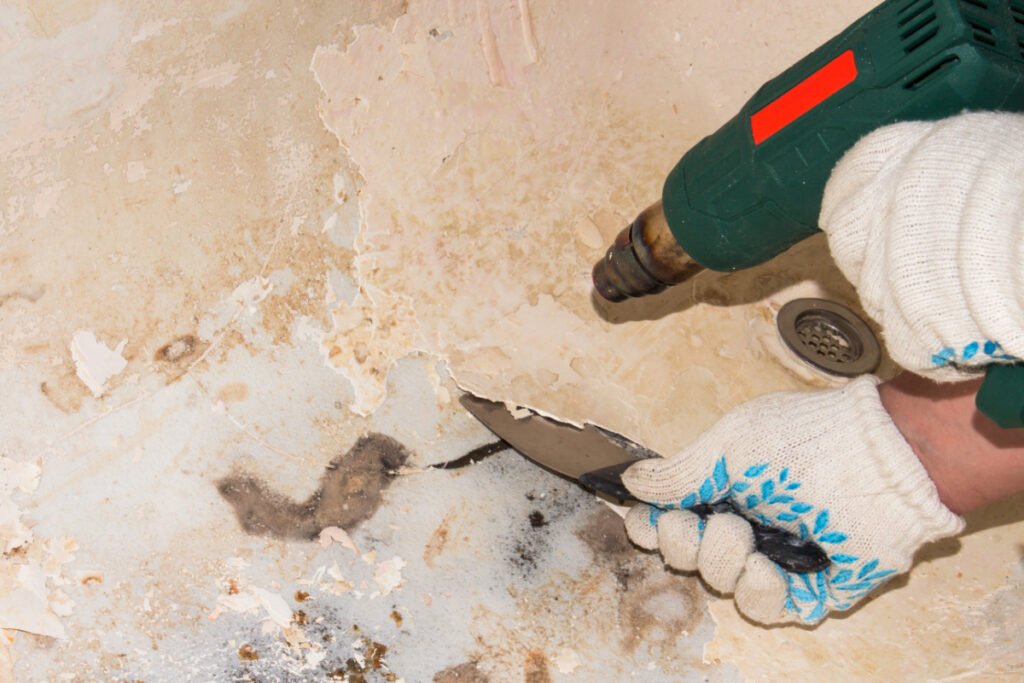
DIY bathtub refinishing kits typically include essential tools and equipment like liquid primers, rollers, cleaners, foam brushes, and trays and offer a one-stop solution for a reglazed bathtub. And, you’ll have a glazed bathtub in about 24-36 hours of following the steps below:
- Get rid of the existing caulk using a caulk remover and cover the ceramic tile, shower head, shower tile, and other hardware with painter’s tape.
- Open the windows and switch on the exhaust for proper ventilation.
- Spray the etching powder on the tub’s surface and rub it with water to remove its existing finish and final coating.
- Sand it a little with high-grit sandpaper and rinse thoroughly to flush all the particles in the drain.
- Finish any cracks and chips with putty and sponge, and apply a latex primer with the help of a roller.
- Now, paint the tub with epoxy paint, cure it for 24 hours, and glaze it with a top coat.
How to Paint a Bathtub Without a Refinishing Kit?
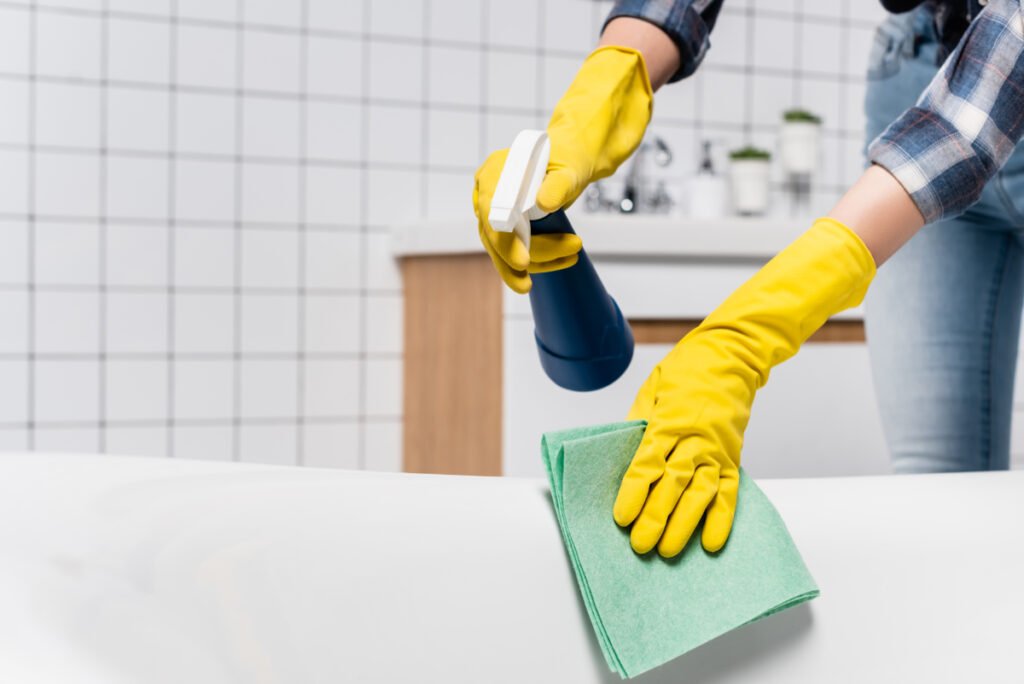
If you are a creative enthusiast, you might already have tons of paint cans and hardeners at your home, and you would not want to invest in a new refinishing kit. In such a case, arm yourself with painter’s tape, hardening solution, and a sponge roller, and we’ll tell you the steps to paint your tub efficiently.
- Clean the bathtub with lime or any powdered cleanser and sand it a little to help stick the paint better.
- Cover all your fixtures and shower heads with painter’s tape and cover the tiles with paper.
- Mix one part of the hardener with two parts of color and add a 10% thinner for easy workability.
- Apply the first coat and let it dry for 2-3 hours.
- Apply the second coat and top it off with any commercial epoxy thinner for more durability.
Tips for Making Bathtub Paint Last Longer
- Always clean the soap scum and grout with a good-quality abrasive cleaner or acetone, as any leftover debris will cause the paint to peel off quickly.
- Scrub any rusted or corroded metal tubs with coconut oil or rust cleaners to create an even foundation for the paint.
- To protect the paint better, clean your bathtub reglazing once a week with any abrasive cleaner that doesn’t contain bleach or ammonia.
- Always use a funnel to pour any drain-fixer or anti-clogger down the trap, as it might remove the paint if it spills on the bathroom vanity.
How Long Does Paint Last on a Bathtub?
Generally, home-painted bathtubs last for about 3-5 years, whereas professionally painted bathtubs can last for nearly ten years. However, with proper maintenance and a top sealing coat, you can extend their durability to 15 years.
How Much Does it Cost to Paint a Bathtub?
Painting bathtubs is affordable. If you decide to paint them yourself, you would spend a maximum of $200. On the other hand, you will need to spend about $500-$700 if you want to hire a professional painter.
Can You Paint a Bathtub Surround?
Yes, you can paint a bathtub’s surrounds, but since they are huge, they might be challenging to paint with a brush and roller. Instead, pick an epoxy or acrylic spray gun, and you can finish painting much more efficiently.
Can You Powder Coat Bathtubs?
Yes, you can powder coat metal and porcelain bathtubs to protect them from rusting and moisture and still have a smooth finish. However, powder coating is expensive and requires tedious prep work that might be time-consuming.
Bathtubs are expensive and challenging to install, and replacing them now and then might be tedious to both the user and his wallet. A quick hack to this problem is repainting them using suitable paints and finishes to enliven your bathroom decor on a budget.
However, just painting them repeatedly is not enough, and you’ll need to ensure fast drainage to make them last longer. So, learn about different types of bathtub drain stoppers and pick the best one for yours!

